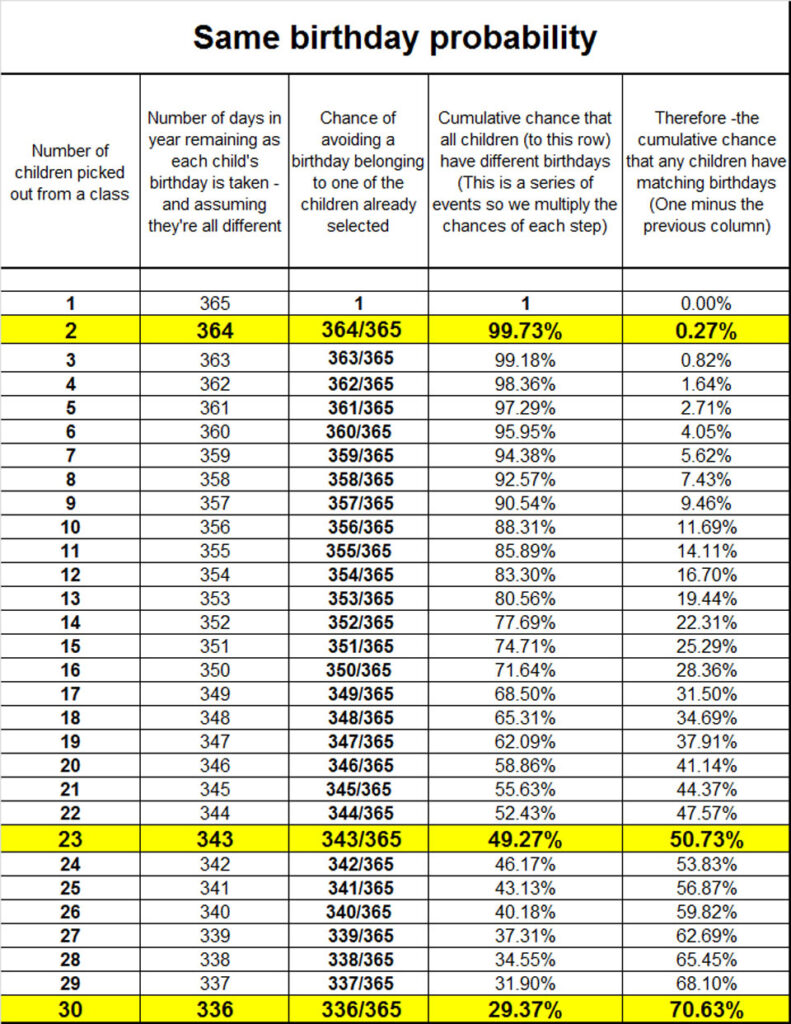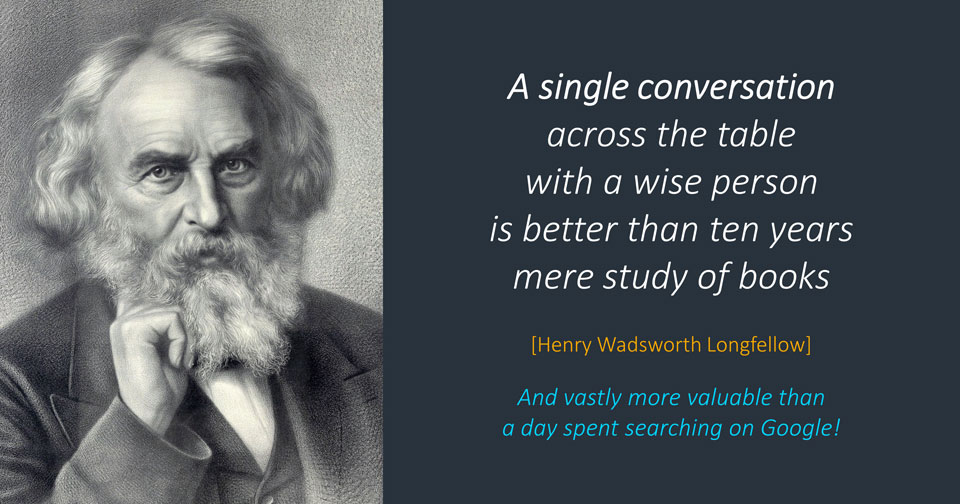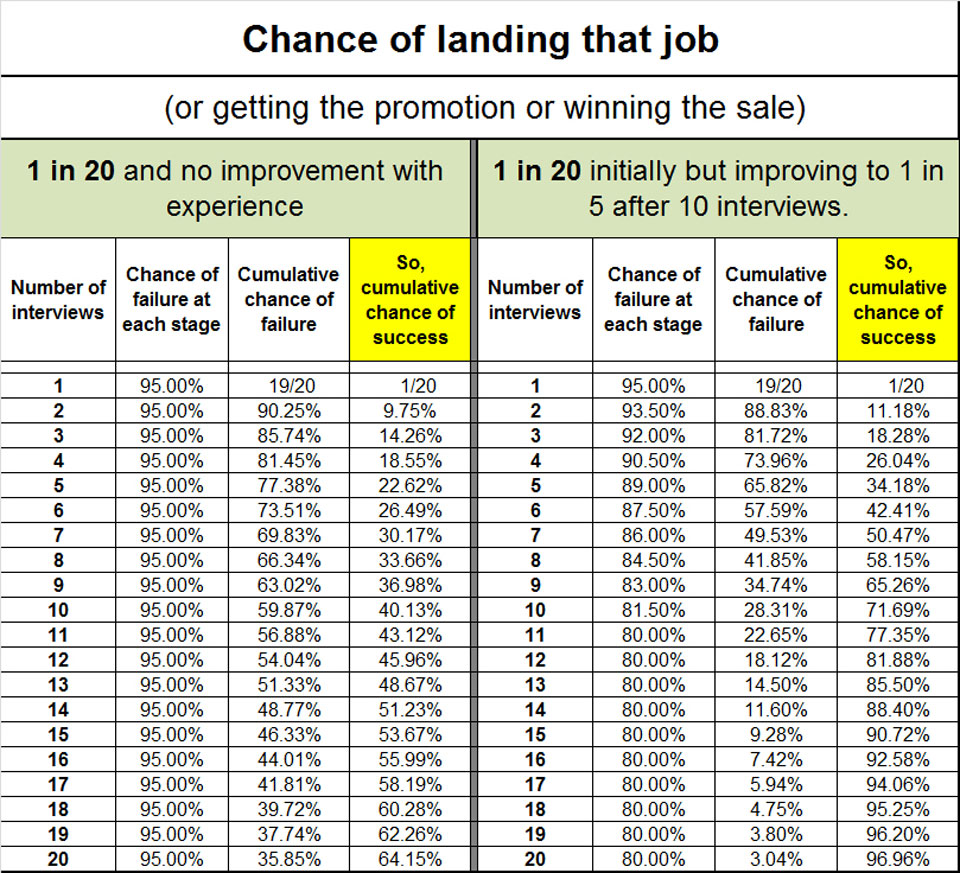
A 5 to 10-minute read – depending on your speed. In our ‘About Money’ article on why financial planning is not common sense, we asked you to guess the answer to this same-birthday riddle.
And if you’ve not yet read that ‘About Money’ article, start there.
What’s the point of the same birthday riddle?
On difficult questions (about money and life, for example), our intuition (gut feelings) can give us wildly inaccurate answers.
Have a go at guessing the answer to this riddle for compelling proof of that.
The riddle is this:
In a class of thirty children, what is the chance that any two (or more) of them have the same birthday?
And, in this ‘About Money’ article, we’ll show you:
- How to work out the answer to this and similar riddles.
- How to use the key insight from this riddle to your advantage in life.
If you’re not interested in number proofs, skip here to the second idea.
Either way, be sure to read the main ‘About Money’ article on why financial planning is not common sense.
The birthday riddle explained
Most people are gobsmacked to learn that, in a group of 30 people, there’s a 70% chance that at least two will have the same birthday.
70% is vastly more than the ‘common-sense’ answers most people give.
Many people guess the answer to this riddle is 1 in 12 (or 8.33%) by dividing the number of children (30) by 365, the number of days in a year.
That approach feels right, but the answer it gives is way off the mark.
The answer (70%) is eight times that of 8.3%!
Others give estimates as low as 3% (1 in 30)
This also uses the number of children, but that approach also lacks solid logic and takes us even further away from the right answer.
How do we solve this riddle?
In short, there is no easy, common-sense way to approach this.
The question would be relatively easy if we asked:
‘What is the chance of a specific child (Sam, for example!) having the same birthday as any other child in the class?
The answer to that question would indeed be around one in twelve or 8.3%.
However, that is not our question.
We want to know the chance that any child has the same birthday as any other.
And it turns out that these sorts of problems are impossible to solve head-on.
So, to solve it, we must turn the question on its head.
We must first find the chance of our event not happening!
And we’ll call that chance ‘N’.
Then, we can calculate the chance of the event happening – by subtracting ‘N’ from 100%.
What?
Yes, well, the chance of something not happening and the chance of it happening always add up to 100%.
Think about the chance of it raining plus the chance of it not raining tomorrow.
They must add up to 100% – because there are no other alternatives.
So, to solve (and understand) the ‘same birthday’ problem, follow these steps:
Step 1: Select any two children from the group to find the chance that they do not have the same birthday. The chance of this first non-matching birthday event is, of course, 364/365.
Step 2: Pick a third child (at random) to find the chance of this third child not having the same birthday as either of the first two. Remember, at this stage, we want to know the chance that none of the children share birthdays.
So, assuming the first two children had different birthdays, their two birthdays are now used up – which means the chance of this next (non-matching) event must be 363/365.
Got it?
Step 3: Continue selecting children from the class one by one.
In each case, we find the chance that the next child does not have the same birthday as any of those already selected.
We continue this process for as many people as we have in our group, which is 30, for our classroom example.
Step 4: To find the cumulative chance of all of these 30 children not having the same birthday, we multiply the chances of each step above.
We multiply because we want to know the chance that: The first two children don’t have the same birthday, and the third child doesn’t have the same birthday as either of the first two, and the fourth doesn’t have the same birthday as any of the first three, and so on.
Step 5: To find the chance that any two (or more) children actually have the same birthday, we deduct the answer in Step 4 (N) from 100%.
Here’s the table of the calculations.

Note how you only need a group of 23 people to have a 50:50 chance of two people in a group having the same birthday.
So, what on earth is the value of this to you?
Good question – and we will get to that, as promised. But first be clear on the key ‘About Money’ article from these tables, which is that: Some (apparently remarkable) events happen far more often than we think.
For example: Have you ever bumped into someone you know when you’ve been on holiday?
Many of us have, and the probability calculation we used in the same birthday riddle explains why it’s not unusual to bump into people we know (or know of) when on holiday or at the airport.
It would be extraordinary to name a specific friend (like Sam!) before your holiday – and then bump into that person!
But it’s no miracle at all to see someone – of all the people you know or know of – while on a holiday.
Events we think of as ‘incredible’ are not that surprising at all.
Does this spoil the idea of serendipity in life?
Possibly, to some extent, but we think it’s important to know.
After all, these simple stats help us to debunk some popular but whacky ideas.
Take the Secret Law of Attraction, for example, which suggests that the Universe listens to our thoughts and makes our dreams a reality!
Our birthday probability riddle is useful, but I must confess, these (smart science) guys do a better job of debunking this and other flawed ideas in their various videos. Take a look.
We need to visualize the right thing.
You may also know of some famous (self-help) gurus (and less famous life coaches) who encourage us to visualize a ‘better future’, perhaps in our minds or with a picture collage on paper.
These coaches say that if we put enough effort into visualizing our dreams, we can literally ‘attract’ them into our lives.
Of course, this ‘law of attraction’ idea is complete nonsense, and the hard evidence is clear and unsurprising.
To achieve our dreams, we need to spend less time dreaming about them and more time doing the necessary work!
Watch Dr Richard Wiseman’s excellent 1-minute video summary of this here.
Years of research by psychologists have shown that we’re far more likely to achieve our goals if we look for and face the obstacles in our way and then plan how we’ll overcome those barriers and get to work. Yes, it’s true that visualization can help us achieve more. But that’s where the visualization is focused on the next action we need to take towards our goal.
Putting all our efforts into visualising our end goals (our dream life) is not just a waste of time, it’s counterproductive for the very people who most need help.
So, the law of attraction is a dangerous idea.
If you want to visualize anything, picture yourself doing the next piece of work in your plan. That may make it easier to start working on it.
This approach (of facing our obstacles) has been proven to work in years of research by Psychologist Gabrielle Oettingen.
Yes, this goes completely against the tired and homespun ideas of old-school motivational coaches.
But the evidence is clear: We need to focus on the obstacles to our goals—and what we’ll do to overcome them—to achieve more in many areas of life, from health and fitness to business success.
And we may expand on this idea in the future. For now, here’s more evidence of how ‘dream boards’ hold people back!
Back to the birthday riddle benefits.
Perhaps you already know that (unplanned) surprising events are random, and dreaming about our goals is a waste of our time.
However, it’s hard work for anyone to consistently put in the effort required to achieve their goals.
So, we recommend you save yourself time and stress by taking wise advice on your direction, too.

That said, even with good guidance or coaching, we all face situations in which we may feel the odds are stacked against us.
And this is where the birthday riddle sums really can help.
Try this thought experiment.
Imagine that things are hard for you at work.
You’re fed up with your current job and want a new role or promotion.
Or, perhaps you work in business development and need to make more sales.
How many people who work in sales, don’t need more sales?
Let’s also assume there’s a lot of competition for the work roles (or sales) you want. So, let’s say your chances of success (at an interview or in a sales pitch) are just one in twenty – or 5%.
That’s a depressingly low chance of success, right?
And it would tempt many to give up on their wish and resign themselves to their current situation.
The question is whether you’re right to feel down about your chances of success.
If you consider this challenge a series of events (like the birthday riddle), you see that your cumulative chance of success grows very quickly if you keep trying.
Indeed, your chance of landing that job – or making that sale – rises to nearly 65% after just 20 attempts.
What’s more, if you assume that your ‘pitching’ performance improves (just a little) with each failed attempt (and why would it not if you took good advice?), then your chances of success rise above 50/50 after just seven attempts.
And after 20 attempts, you have a 97% chance of success.
The odds really don’t get better than that, do they?
Here’s the table with the numbers if you need them.

Onwards and upwards

OK, so perhaps these ideas are not new to you.
After all, it’s 125 years since Thomas Edison observed that:
“Genius is 1 per cent inspiration. And 99 per cent perspiration”
And it’s 17 years since American artist Chuck Close said:
“Inspiration is for amateurs—the rest of us just show up and get to work. If you wait around for the clouds to part, and a bolt of lightning to strike you in the brain, you are not going to make an awful lot of work.
All the best ideas come out of the process; they come out of the work itself.”
However, we think it’s nice to know that the numbers back up these ideas!
And we hope you’ll share this with anyone you think might be waiting for the Universe to deliver their important life goals.
We all know they will wait forever!
Thanks for dropping in.


